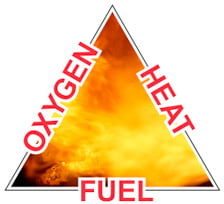
There are three basic conditions that must be satisfied for a fire or explosion to occur:

These three elements combine to form what is known as the combustion triangle. In applying these principles, the quantity of the flammable liquid or vapor that may be liberated and its physical characteristics must be recognized. Vapors from flammable liquids also have a natural tendency to disperse into the atmosphere, and rapidly become diluted to concentrations below the lower explosion limit, particularly when there is natural or mechanical ventilation. In order to have an explosive gas atmosphere, the concentration of the gas or vapor must be above the Lower Explosive Limit (LEL) but below the Upper Explosive Limit (UEL). The possibility that the gas concentration may be above the upper explosion limit does not afford any degree of safety, as the concentration must first pass through the explosive range to reach the upper explosion limit. You can eliminate a combustion hazard by eliminating any one of the three triangle elements.